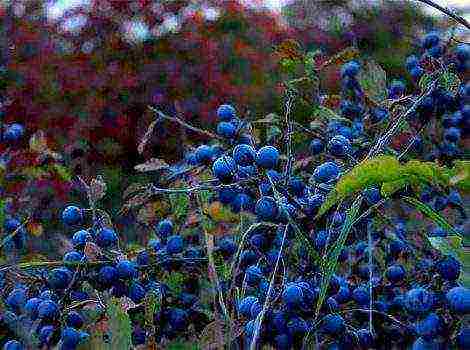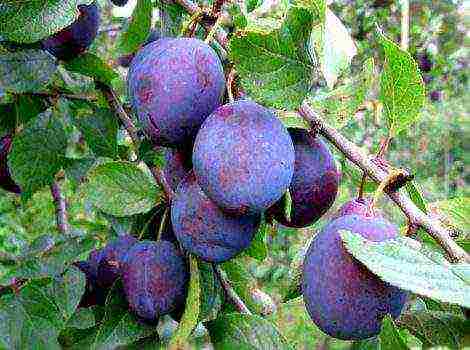Content
Plum is one of the most popular fruit trees, known to summer residents of almost all regions of Russia.
This stone fruit has a huge varietal variety and is the leader among all fruit trees in terms of the number of species. A yellow, red, blue, large or smaller plum, it pleases with its rich harvests, attracting more and more people who want to plant such a tree on their site.
There are effective ways to propagate plums on your own. and grow an excellent harvest on this tree. Plum is very susceptible to reproduction: it takes root easily, gives growth, it has rather high adaptive properties.
Consider artificial (grafting, cuttings) and natural (root shoots, seeds) methods of plum propagation.
This way of breeding plums most common for dark varieties.
The soil is prepared in advance for planting a green cuttings - a mixture of peat and sand will create an optimal microclimate; before direct planting, good soil moistening and fertilization are needed (for example, superphosphate - 1 tsp per 10 liters of water).
Shoots are selected on the mother tree, which will be cut - firm and acquiring varietal reddish tint.
After the preparatory work cuttings are planted in the ground about 3 cm deep (without closing the bottom sheet), the distance between plantings is 7x7 cm.
Experienced gardeners recommend creating a good microclimate for planted cuttings - several times a day, gently moisten the soil, cover the planting with a film, making sure that the temperature under it does not rise above 30˚С.
After 15-20 days, the film can be removed, during this time the first roots should appear and the plants will need ventilation and oxygen.
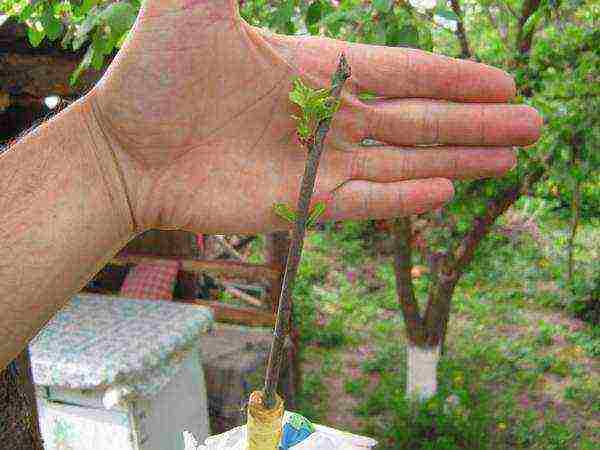
The timing of propagation by cuttings determines the success of the result. Cuttings are cut in the middle of summer, preferably in the early morning or evening, in the process of germination, it is important for them to avoid excessive heat and cold, for which a greenhouse film is installed.
For the winter, it is recommended to sprinkle the established cuttings with peat or fallen leaves to avoid frostbite on young roots.
How to root green cuttings:
How to propagate by root shoots?
The method of propagation of plums from root shoots is universal., which is recommended to be removed, since it takes away the fruitful forces of the mother tree.
A small young shoot (up to 50 cm in height) from this growth can become material for planting. The shoot should grow at a distance of about 1 m from the main tree, be well developed, not affected by insects.
When choosing, a developed root system is important, which will allow the shoot to easily take root in a new place.
The shoot is neatly separated from the main roots of the mother plum, the place where the root was cut is sprinkled with ash. The separated shoot is placed in a well-moistened soil, in a shady place, where it will adapt to new conditions - independent growth.

Its tip is pinched... As a rule, after a month, fresh leaves will appear on it - this means that the rooting process was successful.
Plum is an unpretentious plant that can multiply by root shoots and adapt on its own, which only confirms this. but a young seedling needs good care and timely fertilization.
A month after transplanting the shoot, the plum is required the first feeding - saltpeter, azophos, nettle infusion or cow dung, which are diluted in water... Feeding can be done every two weeks to keep the plant strong.
Grow a plum from a seed? Maybe!
Plum seed propagation is also often used. gardeners. At the same time, it is unlikely that varietal properties will be preserved, here special observations of the seedlings, control and selection of the best ones are required, only then will a varietal plum be obtained.
You may be interested in our publications:
- How to grow a stone plum at home?
- How to prune a plum correctly?
- When and how to properly collect plums from a tree?
For planting with seeds, it is necessary to prepare the planting material. The famous breeder V.N. Shalamov writes that the fruit from which the seeds are taken must be completely ripe, after removal, it is left to the limit of lying, only then the bones are removed from it.
They are freed from the pulp, washed and dried naturally, avoiding sunlight. Dried seeds are transferred to a plastic bag, covered and stored until autumn or spring planting at room temperature.
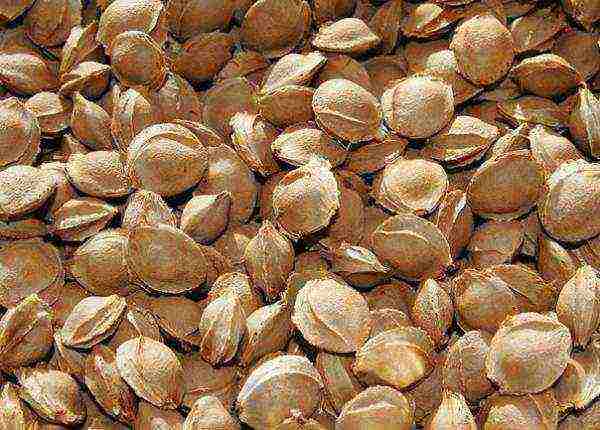
The process of ripening of seeds in plums of different varieties takes up to 180 days.During this period, many breeders suggest mixing selected plum seeds with wet sand and keeping them in a refrigerator or a special box, dug into the ground and protected from water, insects and rodents.
After such storage, many seeds hatch, which means that the planting results will be more successful.
Planting prepared seeds occurs in spring or autumn., in a well-prepared and fertilized soil (V.N.Shalamov recommends fertilizing 1 square meter of planting beds with a mixture of humus (4-6 kg), superphosphate (70 g), potassium salt (30 g), ammonium nitrate (30 g) and lime (50-90 g).
Seeds are placed in the ground to a depth of 2-3 cm, spine down or the place where the root should appear, the distance between the seeds is 30x10 cm. The seeds are covered with fertile soil.
During the entire period of growth, the land must be free from weeds, moistened and loosened, pest infestation must be carefully avoided. After 1-2 years, the selected seedlings can be transplanted to a permanent place..
The criteria for vitality and future yield are how the seedling has grown in one season. The better the growth, the higher the winter hardiness and vitality.
Grafting as a way to preserve varietal species
This method is the most successful to preserve the varietal qualities of the plum. Rootstock, i.e. the base on which the grafting is made is usually grown from seed, less often from root shoots.
Extra leaves and branches are removed in advance, it is watered abundantly to activate sap flow. The rootstock should not be more than one year old; it is desirable that its mother tree be a winter-hardy plum.
A graft can be a bud or a stalk, each has its own methods of grafting.
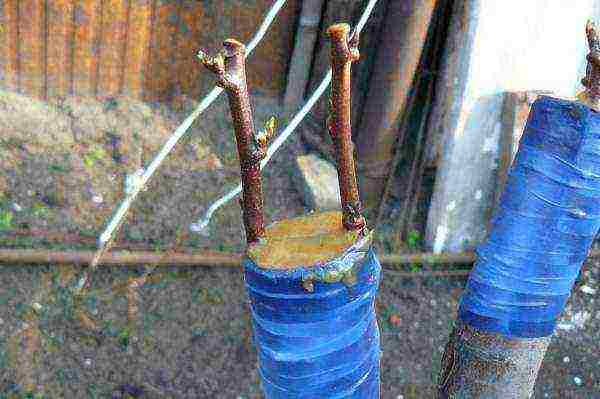
Kidney grafting is called budding... A bud is cut from a varietal tree with a special budding knife - a strip of bark about 3 cm and about 0.5 cm thick with a highly developed bud. An incision is made at the rootstock at a level of about 4 cm from the soil, where, carefully bending back the bark, a shield with a bud is inserted.
Budding can be done in another way, when the scion is cut with a wedge with a thorn up to 15 cm above the bud, which is inserted under the prepared tongue on the rootstock. In this case, it is recommended to graft two buds on one rootstock at once - at a distance of about 4 cm and 11 cm from the soil, in order to increase the success of the grafting.
The place of budding is neatly tied with polyethylene, leaving only the kidney open. The harness is removed 3 weeks after vaccination.
Grafting with cuttings has a longer preparation... Cuttings are harvested in advance and stored during the autumn-winter season and are grafted in two ways: in the split or behind the bark.
Cleavage suggeststhat the rootstock and scion are of approximately the same thickness, but this is not a prerequisite. The stock is cut horizontally and a vertical split is made in the center with a depth of no more than 3 cm (if the stock is a stump left over from an old plum, then the depth does not exceed 7 cm).
The stalk should be cut so that 4-5 eyes remain above the place of the intended alignment. The lower part of the cutting is cut with a wedge similar to the rootstock (no more than 3 cm for a young rootstock). When in contact, the scion and stock should be tightly pressed against each other.
Bark grafting is carried out only with active sap flow, then the bark easily moves away from the stock. It is carefully cut, if it is supposed to plant several cuttings at the same time, then in several places.
The stalk is cut obliquely and connected to the stock. The connection should be tight, it is desirable that the wood layers come together.
After connecting the cutting to the stock, the grafting site is tightly tied with polyethylene, electrical tape or special elastic tape. The remaining open places are densely covered with garden varnish.
Until the first leaves, it is advisable to protect the vaccine from moisture, excess solar heat - the vaccination site is shaded and covered with a transparent bag.
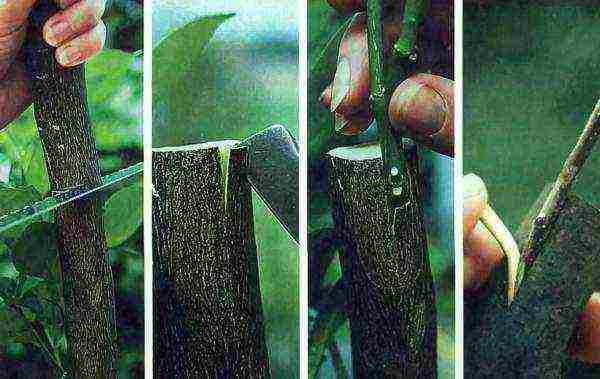
Planting in fall, spring or summer: seasonal features
Faced with the issue of plum breeding, many are wondering about the best time for him... Summer warmth, like the beginning of spring and autumn in different climatic zones, has its own boundaries. This critical factor must be taken into account when determining the time for breeding.
It is also important that reproduction of plums can have a rather lengthy preparatory stage, for example, when preparing seeds or storing root shoots or cuttings. All of them, as a rule, are collected in the summer-autumn period and stored until spring.
Reproduction of fruit trees:
Each plum multiplication action has its own seasonal terms:
- autumn and spring planting of root shoots creates favorable conditions for the development of plums. Autumn planting is carried out under frost (October), spring planting is recommended immediately after the main water disappears (April-early May);
- vaccination is always carried out in the summer, during the period of the greatest sap flow of plants, during this period there is a good survival rate of the scion;
- seed reproduction (after the preparation of the seed) is carried out in the spring.
Although plum is an unpretentious plant, it requires care and maintenance. at all stages of its growth.
To propagate plums, having received excellent varietal qualities and good adaptability, attentive attitude, regular watering, feeding and monitoring the grown pets will help.
